词汇学 词意义共23页文档
- 格式:ppt
- 大小:3.51 MB
- 文档页数:23
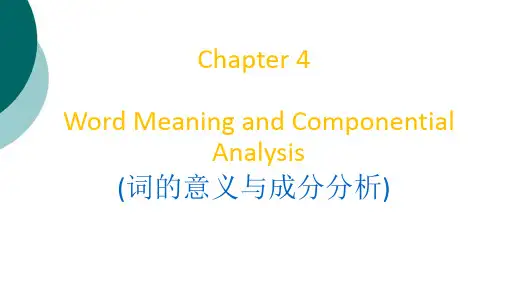
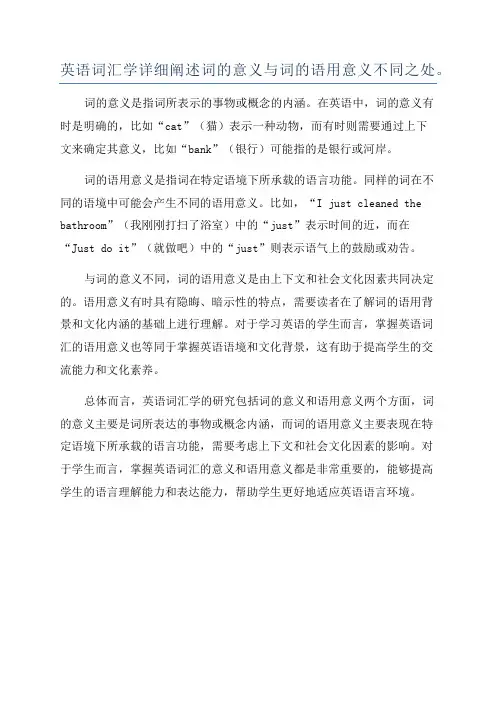
英语词汇学详细阐述词的意义与词的语用意义不同之处。
词的意义是指词所表示的事物或概念的内涵。
在英语中,词的意义有
时是明确的,比如“cat”(猫)表示一种动物,而有时则需要通过上下
文来确定其意义,比如“bank”(银行)可能指的是银行或河岸。
词的语用意义是指词在特定语境下所承载的语言功能。
同样的词在不
同的语境中可能会产生不同的语用意义。
比如,“I just cleaned the bathroom”(我刚刚打扫了浴室)中的“just”表示时间的近,而在
“Just do it”(就做吧)中的“just”则表示语气上的鼓励或劝告。
与词的意义不同,词的语用意义是由上下文和社会文化因素共同决定的。
语用意义有时具有隐晦、暗示性的特点,需要读者在了解词的语用背
景和文化内涵的基础上进行理解。
对于学习英语的学生而言,掌握英语词
汇的语用意义也等同于掌握英语语境和文化背景,这有助于提高学生的交
流能力和文化素养。
总体而言,英语词汇学的研究包括词的意义和语用意义两个方面,词
的意义主要是词所表达的事物或概念内涵,而词的语用意义主要表现在特
定语境下所承载的语言功能,需要考虑上下文和社会文化因素的影响。
对
于学生而言,掌握英语词汇的意义和语用意义都是非常重要的,能够提高
学生的语言理解能力和表达能力,帮助学生更好地适应英语语言环境。
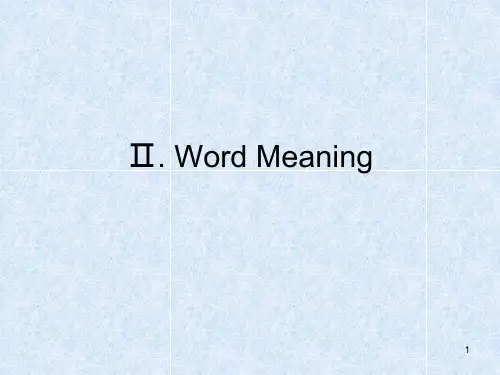

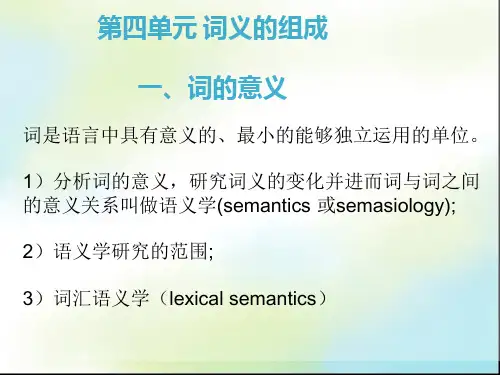
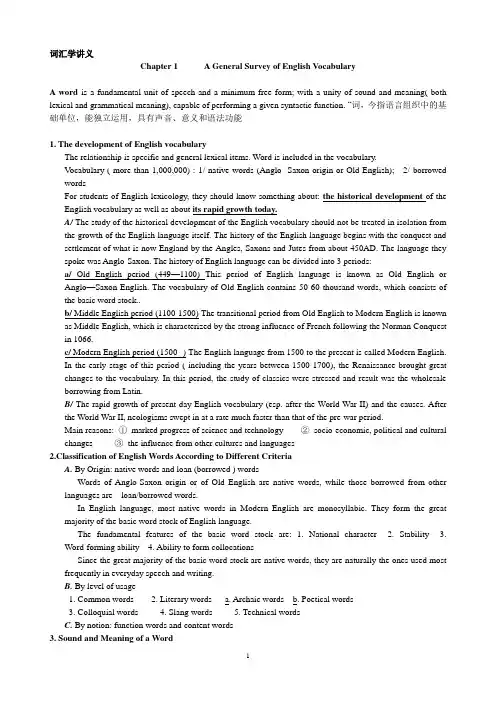
词汇学讲义Chapter 1 A General Survey of English VocabularyA word is a fundamental unit of speech and a minimum free form; with a unity of sound and meaning( both lexical and grammatical meaning), capable of performing a given syntactic function. ―词,今指语言组织中的基础单位,能独立运用,具有声音、意义和语法功能1. The development of English vocabularyThe relationship is specific and general lexical items. Word is included in the vocabulary.V ocabulary ( more than 1,000,000) : 1/ native words (Anglo- Saxon origin or Old English); 2/ borrowed wordsFor students of English lexicology, they should know something about: the historical development of the English vocabulary as well as about its rapid growth today.A/ The study of the historical development of the English vocabulary should not be treated in isolation from the growth of the English language itself. The history of the English language begins with the conquest and settlement of what is now England by the Angles, Saxons and Jutes from about 450AD. The language they spoke was Anglo-Saxon. The history of English language can be divided into 3 periods:a/Old English period (449—1100) This period of English language is known as Old English or Anglo—Saxon English. The vocabulary of Old English contains 50-60 thousand words, which consists of the basic word stock..b/ Middle English period (1100-1500) The transitional period from Old English to Modern English is known as Middle English, which is characterized by the strong influence of French following the Norman Conquest in 1066.c/ Modern English period (1500--)The English language from 1500 to the present is called Modern English.In the early stage of this period ( including the years between 1500-1700), the Renaissance brought great changes to the vocabulary. In this period, the study of classics were stressed and result was the wholesale borrowing from Latin.B/ The rapid growth of present-day English vocabulary (esp. after the World War II) and the causes. After the World War II, neologisms swept in at a rate much faster than that of the pre-war period.Main reasons: ①marked progress of science and technology ②socio-economic, political and cultural changes ③the influence from other cultures and languages2.Classification of English Words According to Different CriteriaA. By Origin: native words and loan (borrowed ) wordsWords of Anglo-Saxon origin or of Old English are native words, while those borrowed from other languages are loan/borrowed words.In English language, most native words in Modern English are monosyllabic. They form the great majority of the basic word stock of English language.The fundamental features of the basic word stock are: 1. National character 2. Stability 3.Word-forming ability 4. Ability to form collocationsSince the great majority of the basic word stock are native words, they are naturally the ones used most frequently in everyday speech and writing.B. By level of usage1. Common words2. Literary words a. Archaic words b. Poetical words3. Colloquial words4. Slang words5. Technical wordsC. By notion: function words and content words3. Sound and Meaning of a Word2 schools about the relation of sound and meaning of a word:a/ the Naturalists: Their opinion is that there is an intrinsic correspondence between sound and meaning.b/ the Conventionalists: with an opinion that the relation between sound and meaning of a word is a kind of linguistic social contract.Use the examples on P2 to illustrate the opinions of the 2 schools.Lexical and Grammatical Meaning of a Word•There is a close relation between lexical and grammatical meaning of a word; lexical meaning is changing with the change in grammatical meaning.Meaning and Concept of a Word:Meaning is closely related to a concept. A concept is the base of the meaning of a word. A word is used to label a concept. It acts as the symbol for that concept. The concept is abstracted from the person, thing, relationship, idea, event, and so on, that we are thinking about. We call this the referent. The word labels the concept, which is abstracted from the referent; the word denotes the referent, but does not label it. Their relation can be diagrammed as follows:Word --- Meaning ( concept) --- referent词意义(概念)所指对象This formula shows that the word refers to the referent through a concept.A concept is an abstraction from things of the same kind.Notes: 1/词由一定的形式(发音与书写)2/ 每个词都有一定的形式与概念,这两方面缺一不可,统一在每个词中。

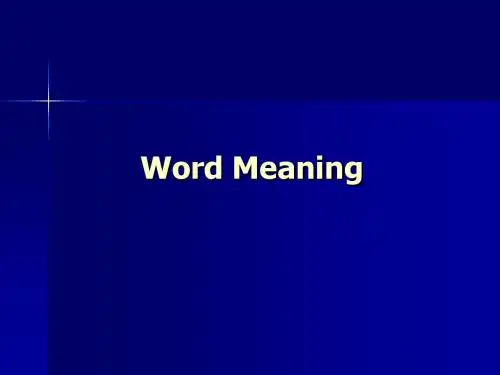
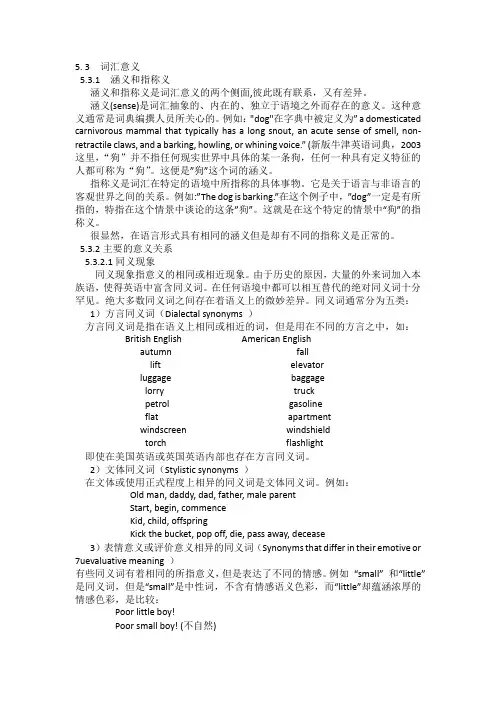
5. 3 词汇意义5.3.1 涵义和指称义涵义和指称义是词汇意义的两个侧面,彼此既有联系,又有差异。
涵义(sense)是词汇抽象的、内在的、独立于语境之外而存在的意义。
这种意义通常是词典编撰人员所关心的。
例如:"dog"在字典中被定义为” a domesticated carnivorous mammal that typically has a long snout, an acute sense of smell, non-retractile claws, and a barking, howling, or whining voice.” (新版牛津英语词典,2003 这里,“狗”并不指任何现实世界中具体的某一条狗,任何一种具有定义特征的人都可称为“狗”。
这便是”狗”这个词的涵义。
指称义是词汇在特定的语境中所指称的具体事物。
它是关于语言与非语言的客观世界之间的关系。
例如:”The dog is barking.”在这个例子中,”dog”一定是有所指的,特指在这个情景中谈论的这条”狗”。
这就是在这个特定的情景中“狗”的指称义。
很显然,在语言形式具有相同的涵义但是却有不同的指称义是正常的。
5.3.2主要的意义关系5.3.2.1同义现象同义现象指意义的相同或相近现象。
由于历史的原因,大量的外来词加入本族语,使得英语中富含同义词。
在任何语境中都可以相互替代的绝对同义词十分罕见。
绝大多数同义词之间存在着语义上的微妙差异。
同义词通常分为五类:1)方言同义词(Dialectal synonyms )方言同义词是指在语义上相同或相近的词,但是用在不同的方言之中,如:British English American Englishautumn falllift elevatorluggage baggagelorry truckpetrol gasolineflat apartmentwindscreen windshieldtorch flashlight即使在美国英语或英国英语内部也存在方言同义词。
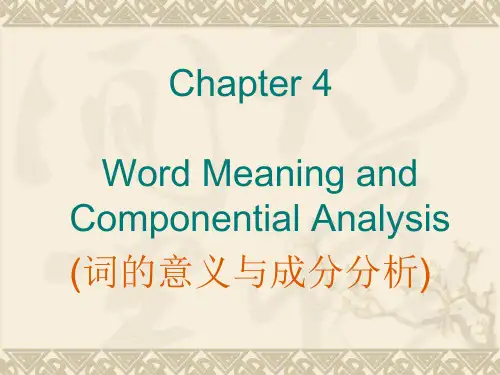

英语词汇学第四章词的意义Words are the building blocks of language and play a crucial role in our ability to communicate effectively. In the field of vocabulary studies, the fourth chapter is dedicated to the study of word meaning, or semantics. This aspect of language is fundamental to our understanding and use of vocabulary, as it delves into the nuances and complexities of how words convey meaning.At the heart of semantics is the concept of lexical meaning which refers to the inherent meaning of a word itself, independent of the context in which it is used. This meaning is often described as the denotative meaning the word carries, or its dictionary definition. For example the word "book" denotes a physical object consisting of pages bound together. This denotative meaning forms the core of the word's semantic representation.However words can also carry connotative meanings which are the associated or implied meanings that go beyond the literal definition. These connotations are shaped by cultural, emotional, and experiential factors and can vary greatly between individuals andcontexts. The word "book" for instance may connotate knowledge, academia, or leisure depending on the person's perspective. Mastering the ability to recognize and utilize both denotative and connotative meanings is crucial for effective communication and language comprehension.Another key aspect of word meaning explored in this chapter is sense relations which examine how words relate to and interact with one another semantically. These relations include synonymy where words share highly similar meanings like "large" and "big", antonymy where words have opposite meanings like "hot" and "cold", and hyponymy where a word is a type or instance of a more general category like "rose" is a hyponym of "flower". Understanding these sense relations allows us to build connections between words, expand our vocabulary, and communicate with greater precision.Polysemy is another important semantic concept covered in this chapter. This refers to a single word having multiple distinct meanings, often related in some way. The word "bank" for instance can mean a financial institution, the edge of a river, or the list of backup data. Polysemy adds richness and flexibility to language but can also lead to ambiguity if the intended meaning is not clear from the context.Closely tied to polysemy is the notion of homonymy where two ormore words are spelled and pronounced the same but have completely unrelated meanings, such as "bat" the flying mammal and "bat" the sports equipment. Differentiating between polysemy and homonymy is an important skill for developing nuanced vocabulary comprehension.The chapter also delves into semantic change examining how the meanings of words can evolve over time. Words may undergo semantic broadening where the meaning expands, narrowing where the meaning becomes more specific, or even complete shifts in meaning. For example the word "nice" originally meant "foolish" or "stupid" but over centuries has come to mean "pleasant" or "agreeable." Tracking these semantic changes is crucial for understanding the dynamic nature of language.Semantic field theory is another key concept explored, which posits that words cluster together into semantic fields or lexical sets based on shared meanings or conceptual associations. For instance, words related to the "kitchen" semantic field might include "stove," "oven," "utensil," "ingredient," etc. Recognizing these semantic connections allows us to organize our vocabulary more effectively and make informed guesses about unknown words.The chapter also covers the role of context in determining word meaning. The same word can take on vastly different meaningsdepending on the surrounding text, tone, situation, or intent of the speaker. For example the word "table" has a different meaning in the phrases "set the table" versus "table the discussion." Mastering the ability to derive meaning from contextual cues is essential for fluid language comprehension.Figurative language is another critical aspect of semantics discussed in this chapter. This includes metaphors, similes, idioms, and other expressions where words take on non-literal meanings. For instance, saying someone has "a heart of gold" is a metaphorical way of describing their kind and generous nature. Familiarity with common figurative expressions and the skill to interpret their intended meanings are hallmarks of advanced vocabulary knowledge.Semantic analysis also involves examining the morphological structures of words and how the combination of roots, prefixes, and suffixes contribute to overall meaning. For example, the word "dislike" is composed of the root "like" combined with the prefix "dis-" to indicate the opposite. Understanding these morphological building blocks empowers learners to decipher the meanings of unfamiliar words.Finally, the chapter explores the role of semantic networks and how words are cognitively organized in the mind. Researchers have found that words are not stored in isolation but are interconnected basedon meaning, sound, spelling, and other associations. These semantic networks allow us to rapidly retrieve words, make connections, and engage in higher-order thinking about language.In conclusion, the fourth chapter of vocabulary studies provides a comprehensive exploration of the semantic dimension of words. From denotation and connotation to sense relations, polysemy, semantic change, and figurative language, this chapter equips learners with a robust understanding of how words convey meaning. Mastering these semantic concepts is essential for developing strong vocabulary skills, engaging in nuanced communication, and deepening one's overall language proficiency.。
词汇意义的名词解释词汇意义是语言学中重要的概念,它涉及到词汇的语义(即词的意义)以及词的语用(词在具体语境中的使用效果)。
词汇意义不仅仅是词语的定义,它还包括了词语在不同语境中的隐含意义和引申义。
在本文中,将从几个角度对词汇意义进行解释和探讨。
一、词语的语义词语的语义是指词的本义或基本意义。
它是单词在词典中给出的定义,是最基本的词汇意义。
不同的词语在不同的语言中可能有不同的词义。
例如,“apple”(苹果)在英语中表示一种水果,而在计算机领域中则表示一种设备。
词语的语义是学习语言的起点,在不同的语境中,词的语义也可能会有所改变。
二、隐含意义词语的隐含意义是指词语在特定语境中所暗含的意义。
它比词语的字面意义更加丰富和深入。
隐含意义通常需要依赖于上下文才能理解。
例如,“他的房子真不错!”这句话中,“不错”一词的字面意义是“好”,但在这个语境中,它的隐含意义是“非常好”。
隐含意义是语言中常见的现象,通过理解隐含意义,我们可以更好地理解他人的意思以及进行有效的沟通。
三、词语的引申义词语的引申义是指词语在语言使用中所产生的特定的扩展意义。
它是围绕着原始的词义而发展起来的,可以通过词语的比喻、类比、借代等方式实现。
例如,“明星”这个词最初指的是天空中的亮光体,后来引申为指代知名演员、歌手等公众人物。
引申义的产生是由于人们在社会和文化发展过程中对于词义的需求,通过引申义,词语可以获得更多的丰富和灵活的意义。
四、词语的语用词语的语用是指词语在实际语言使用中的效果和功能。
它关注的是说话者在具体语境中使用词语时的意图和目的。
语用可以通过语气、语调、语境等方面来实现。
例如,“你真棒!”这句话可能是表示对对方的赞美,也可能是表示对对方的讽刺。
同样的词语在不同的语境中可能产生不同的语用效果。
语用可以增强交流的效果,同时也需要考虑到文化、社会背景等因素。
综上所述,词汇意义是语言学中重要的概念,它包括了词语的语义、隐含意义、引申义和语用。